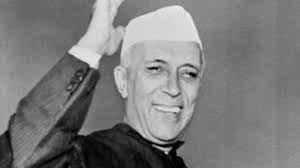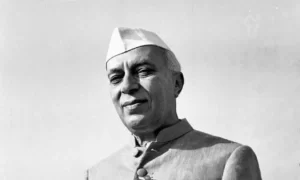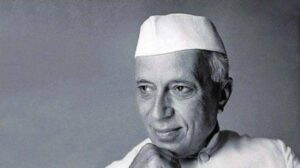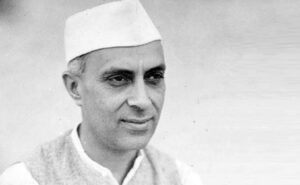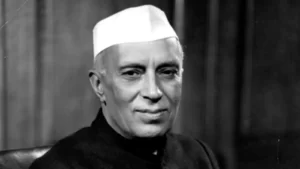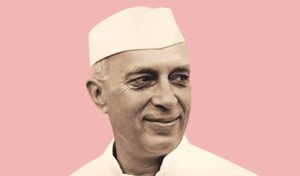Delhi
Here we stand in Delhi city, symbol of old India and the new. It is not the narrow lanes and houses of old Delhi or the wide spaces and rather pretentious buildings of New Delhi that count, but the spirit of this ancient city. For Delhi has been an epitome of India’s history with its succession of glory and disaster, and with its great capacity to absorb many cultures and yet remain itself. It is a gem. with many facets, some bright and some darkened by age, presenting the course of India’s life and thought during the ages. Even the stones here whisper to our ears of the ages of long ago and the air we breathe is full of the dust and fragrance of the past as also of the fresh and piercing winds of the present. We face the good and bad of India in Delhi city which has been the grave of many empires and the nursery of a republic. What a tremendous story is here; the tradition of millenia of our history surrounds us at every step, and the procession of innumerable generations passes by before our eyes..
Old Delhi: Shahjahanabad
The past in India surrounds us everywhere. If you go for a drive in Delhi, it comes up before you in the shape of old ruins. Indians on the whole are said to be not a history-conscious people, like the Arabs or the Chinese. But we have roots in the long past and our sense of history expressed itself in mythology, in epics, in monuments, etc. I am not sure if that method of expression which developed in India was not more powerful in influencing the minds of the mass of the people.
If you take the Jamuna, that very beautiful and gracious river, you get the whole of Krishna legend around about Muttra and Brindavan and of the sweet songs in Braj Bhasha.
I have come back after a long while to my home town of Allahabad to which I have almost become a stranger. During these past fifteen months I have lived in New Delhi, next door to Old Delhi City (Shahjahanabad). What do these two cities convey to us, what pictures and thoughts do they bring to our minds? When I think of them, the long vista of India’s history stretches out before me, and so much the succession of kings and emperors, but rather that of the inner life of a nation, its cultural activities in many fields, its spiritual adventures and its voyages in the realms of thought and action.
Here is this city of New Delhi and Old Delhi is nearby. There are many things in Old Delhi (Shahjahanabad) which, perhaps, many of us and many of you do not like. They are certainly capable of improvement. Nevertheless, there are many things in Old Delhi, old buildings, for instance, which stand out. But there is something more than that. There is the spirit and the genius of an ancient city. where almost every stone tells you a story, where history is embedded even in the dirty lane the history of events and the history of people in their happiness and sorrow through long ages past. There is this ancient city with much that is good and much. that is bad; but it has definite and positive atmosphere which you can feel in your bones if you go there, especially if you know something about the tremendous past of Old Delhi (Shahjahanabad) which is supposed to be the seventh city of Delhi.
Delhi-The Refugee Influx
What applies to Delhi applies equally to great cities like Calcutta and Bombay and it seems to me undesirable to collect any more of such institutions in these big cities. Of course, inevitably a great city attracts other institutions. That process will continue but there is no reason why we should give it a greater push than is absolutely necessary. There is also the terrific problem of accommodation.
In Delhi alone there are three or four lakhs of refugees from the Frontier Province, West Punjab, Ballichistan and Sind. Within a week all the refugees, who have no accommodation, will be provided with accommodation in barracks or elsewhere.
We have provided additional accommodation during the past few days for about 10,000. Our first priority is to make this accommoda tion available to the refugees who have been residing in the mosques in Delhi, secondly, those on the railway station, thirdly, those at the Wavell Canteen. Any person who may have been absolutely shelterless will, of course, be given a high priority.
These are temporary arrangements. The next step which we hope to take very soon is to begin to rehabilitate them in a more permanent way. A large number of plots of land in the Shadipur area of Delhi will be reserved for refugees. similar areas in other places are also under consideration. Within a few days I hope that the announce ment of the new capital for East Punjab will be made and no doubt many people would like to settle down there.
So, although I live in Delhi city, my mind is concerned more and more with the villages of India and how to give them the basic necessities of life, and how to make them self-reliant and capable of looking after themselves.
As you must know we have had to face a terrific problem owing to large-scale migrations of people in the Punjab and elsewhere. We have had to provide for about five million people who have been uprooted and displaced. About four million go to the lands, but one million town dwellers are a much more difficult proposition. Such a problem ought to offer an ideal opportunity for planning both town and rural. But it came upon us so suddenly and in such a magnitude that we were rather overwhelmed and all attempts at planning faded away to begin with. We are trying to plan now to some extent and building townships in developing industrial areas, etc.
About ten days ago I stated that the Government was making every effort to provide some kind of shelter for the refugees in Delhi who lacked accommodation. We have taken this up as an urgent problem of the highest priority because we did not want any single refugee from Pakistan to be without a shelter at least. The problem has been a big one, made all the more difficult by more and more people arriving.
A sufficiently large area near Delhi has been set apart for refugees who will be helped to build houses. The Government will provide them the necessary land and building material. They will also build roads and arrange for water supply. In Delhi, as in other parts of India, small townships will be built for the refugees. They will also be given good land. Middle-class refugees in Delhi will be helped to form corporations for building houses.
We all agree that Delhi should be treated as a special case as the nerve-centre of the country and that life here should be quite normal. The city is certainly unsafe to some extent because of the large number of criminal elements that have come here. We have many lakhs of refugees also and as you might have seen Chandni Chowk is hardly passable because all the pavements and parts of the roads are blocked by refugee stores. We are trying to do our best to ease this situation.
I have been thinking what can be done in order to stop more refugees coming to Delhi. I am afraid can think of no effective method. I think however, that it might be worthwhile for your Ministry to announce publicly that no arrangements will be made in Delhi for newcomers and all these will be sent off immediately to camps in Bihar or elsewhere. If it was done on one or two occasions, it might have salutary effect.
It is important to remember, however, that Delhi cannot possibly absorb or accommodate fresh batches of refugees. If fresh batches come they will have to be sent on to Kurukshetra or other places.
I would earnestly request that no further refugees from Pakistan should come to Delhi as this will not help them in any way. They will merely add to their difficulties as well as ours. It is easier for us to help them in other places and we intend to do so.
Professor Rao talked a great deal about urbanization and the problems of the city of Delhi. These problems are daily before us and daily embarrass us too, considering the slums and all that, which require all the attention we can give them.
Our new Rehabilitation and Development Board will soon be coming out with some of their township schemes near Delhi. 1 suppose some time or other the East Punjab capital will also be announced. All these will make a difference and we may well reconsider the situation in the light of these developments.
There is also a proposal to send them directly to some other place and Chakrata near Mussoorie has been mentioned. I am inclined to think that it would be far better to send them direct to some other place than to crowd them in Delhi. Delhi is getting such an evil reputation because of the vast numbers of refugees. Chakrata is a delightful hill station with military barracks.
You will remember that we came to the conclusion two or three months ago that the areas in Delhi city which are now predomin antly Muslim should for the present be reserved for Muslims. What exactly these areas are, is perhaps a little difficult to define with accuracy and the local authorities have to specify them.
Later the conditions laid down by Bapu at the time of his fast also referred to this matter and we accepted these conditions. I believe that generally speaking this policy has been followed by the local authorities. Since then I realise that this cannot be a permanent policy and some time or other we shall have to consider matters afresh. We cannot keep a large number of houses in Delhi vacant indefinitely. But for the present and for some time to come, we must continue this policy both because we are pledged to it and because it is a right and soothing policy.
If we can create peaceful conditions here, we can change the atmosphere throughout the country. We should create conditions in which nobody should be obsessed by the fear of rioting or be afraid of moving about freely. May be no Hindu or Sikh can live in peace and honour in Lahore. But if we create similar conditions here, what is the difference between them and us? Should we become like them?
You should pledge to bring about complete peace in Delhi. There should be no boycott of Muslims and peaceful relations should be restored. Delhi is not merely the capital of India but a city with a great historical past. Conditions here have their effect on other parts of India. You have to make Delhi the bulwark of peace and harmony.
All this however requires public cooperation and it cannot be done if there is rioting in Delhi. Out of three and a half lakh of Muslims, nearly two lakhs have left Delhi. Many of the mohallas have become empty and Hindus and Sikhs have occupied the houses vacated by Muslims. But it is the policy of the Government to give every facility to Muslims living in Delhi and who are wanting to stay on here.
Planning the National Capital
I wish that all of us really gave thought to it as to how to control New Delhi. Each Hon. Member here has to face the situation. I think the average rent in Delhi is amazingly high. If a person wants to build a house in Delhi, my hon, colleague the Minister of Works. in that particular New Delhi Area charges a premium, which is colossal, apart from the rent and other things.
Then, we have to deal-all of us here, not only Ministers, but Members also with this extraordinary city of New Delhi, which is situated quite near one of the most ancient cities in the world.
Then there is this question of residence and as I said a residence should be a place where a person, a Minister can do work quietly and efficiently. As to the old so-called Minister’s houses, of the old Executive Councillors’ houses, I dislike them intensely from every point of view, whether it is the external appearance or the internal
lay-out or the furniture there or the darkness that surrounds them inside and outside. It is an extraordinary place there, and yet they are big, costly to keep up and a nuisance. I would much prefer convenient and smaller houses. The burden of rent will be less and the burden of upkeep’ will be less too.
In fact, in future, I suppose and I hope that no big houses would be built in Delhi at all. The foreign missions may build them if they like. One of the reasons why New Delhi is so expensive is because of these big houses with large compounds. If you have to go to your next door neighbour, it is half a mile away practically. It is not a city it is a spread out place. So we have to fill that in and make it more like a city so that one can walk across or bicycle across and do things, instead of being forced to maintain a standard which very few people can afford to maintain.
New Delhi attracts large numbers of people for business or pleasure and it has some big and impressive buildings and plenty of offices. Large numbers of people, directly or indirectly concerned with the administration of India, sit in these offices and work away.
But New Delhi has always seemed to me to be a place without a soul and without spirit. In spite of its large structures of stone and brick and in spite of a certain attractiveness which some of the New Delhi buildings may possess, New Delhi is not an attractive place.
This is not so because of the buildings; I am talking more of the atmosphere that surrounds it. Now, you cannot develop the right atmosphere in a city too quickly. But, at any rate, you can lay the foundation for it, you can help that atmosphere to grow.
To have a regular enclave, as suggested, will probably mean much more expenditure also. It would mean more building and more amenities which may not exist now. It will, in fact, mean building a new city on a small scale. That is a tremendous undertaking at any time, more so in the present circumstances when all our resources should be concentrated in providing housing for not only refugees but for large numbers of others who are houseless.
I do not personally appreciate the principle behind it, that is, the idea of having a Central Government enclave at a suitable place away from Delhi. I entirely agree that it is undesirable to concentrate offices in Delhi or even Bombay and Calcutta. I think that everything that can be conveniently moved away to another suitable centre should be moved away. Further that new institutions should, as far as possible, be started at other places than Delhi.
But it is one thing to start these institutions at other places and quite another to choose a special Central Government enclave where they can be concentrated.
It is our general policy to locate central and international organisations in various parts of the country, i.e. not to collect them in two or three principal cities. Thus we have definitely decided that we will not have any such office in Delhi in future, unless there are very urgent reasons for it.
Indeed we are thinking of removing some offices from Delhi and taking them to provincial cities. In the same way we want to spread out several of our national and international organisations all over India so that the whole of India may benefit and there may be no great concentration.
It seems to me easier and more desirable to spread out these offices in various suitable towns and cities of India than to try to develop a miniature Delhi elsewhere. This latter place would have all the disadvantages of Delhi without any of its advantages. That is to say, it will be a relatively small purely governmental centre with no breath of fresh air coming into it. While if institutions or offices are spread out in existing cities and towns they will live a normal life in more normal environments, and they will participate in and add to the amenities of existing cities.
I suggest, therefore, that a provisional rule might be laid down that wherever possible any new offices or institutions should be located at places other than Delhi. The exact place of its location should be decided separately in each case. The first thing to do is to find out what are these new offices and institutions that have to be catered for or that might conveniently be taken away from Delhi. When we have this data, we can consider each one separately.
The Delhi Master Plan has taken us about six or seven years to prepare, even with some of the most competent men that we could obtain.
They worked hard for the planning of Delhi and they have produced a plan. Naturally, they cannot write on a plain surface. They have to accept Delhi city as it is and then plan for its future. That limits one’s efforts but they have produced a plan which I think is a good plan and they expect it to be given effect to in the course of the next 15 or 20 years.
We must work to that end as far as we can and gradually it will take shape. Of course, you can make changes in between, when you want. Whatever the Corporation and the Municipality do must fit into that plan.
I doubt if any other plan has been worked out in such close collaboration with various organizations, parties, states, opinions and viewpoints, in fact, with all the elements that go to make up a nation’s capital. We are dealing with India and not any other country. We should not try to reproduce conditions which obtain elsewhere. I do not say it is perfect, but it keeps on improving. It is a good Plan and if given effect to, it will take us some considerable way along our journey.
We are full of work and worry, but whatever happens we want to go ahead with this planning for development.


